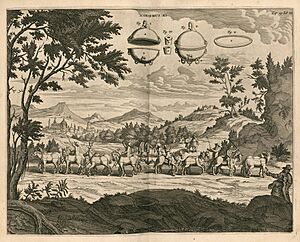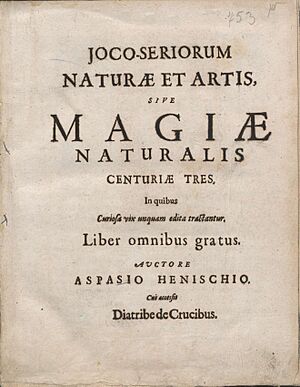Gaspar Schott facts for kids
Gaspar Schott (born February 5, 1608 – died May 22, 1666) was a German Jesuit priest and scientist. He focused on physics, mathematics, and natural philosophy. He was known for his hard work and for collecting a lot of scientific information.
Contents
Life Story of Gaspar Schott
Gaspar Schott was born in a town called Bad Königshofen im Grabfeld, Germany. When he was 19, he joined the Society of Jesus, often called the Jesuits. This is a religious group.
He began studying philosophy at the University of Würzburg. However, in 1631, an army invaded Würzburg. Because of this, Gaspar and other Jesuits had to leave the city. He first moved to Belgium, then to Sicily, an island in Italy. There, he continued his studies in theology.
In 1637, he became a priest. For the next 15 years, he taught and worked in various Jesuit schools in Sicily.
Later, in 1652, he moved to Rome. He became an assistant to his former math teacher, Athanasius Kircher. Kircher was a very famous scholar at the time. Gaspar helped Kircher and also collected his own ideas for future books.
In 1655, Gaspar Schott returned to Germany. He first went to Mainz and then to Würzburg. He stayed in Würzburg until his death in 1666.
Gaspar Schott's Scientific Books
Schott wrote many books about mathematics, physics, and even what people then called "magic." However, he mostly gathered information from other reports, articles, or books. He also described his own experiments. He did not often discover completely new things himself.
Gaspar Schott is best known for his books about tools that use water (hydraulic) and machines (mechanical). One of his books was the first to describe a universal joint. This is a part that allows a shaft to bend in any direction. He also helped classify different types of gear teeth.
One of his most famous works is Magia universalis naturæ et artis. This book had four volumes and was published between 1657 and 1659. It was full of math problems and physics experiments. Many of these experiments were about optics (how light works) and acoustics (how sound works).
His book Mechanica hydraulica-pneumatica (1657) was important. It contained the first description of Otto von Guericke's air pump. This pump could create a vacuum. He also published other works like Pantometrum Kircherianum (1660) and Physica curiosa (1662). The Physica curiosa was an addition to his Magia universalis book. Other books included Technica Curiosa (1664) and Organum Mathematicum (1668). He also edited books by other famous scientists.
Gaspar Schott in Stories
Gaspar Schott was an inspiration for a character in a novel. He helped create the character Gaspar Wanderdrossel. This character appears in the book The Island of the Day Before by Umberto Eco.
See also
- List of Jesuit scientists
- List of Roman Catholic scientist-clerics



